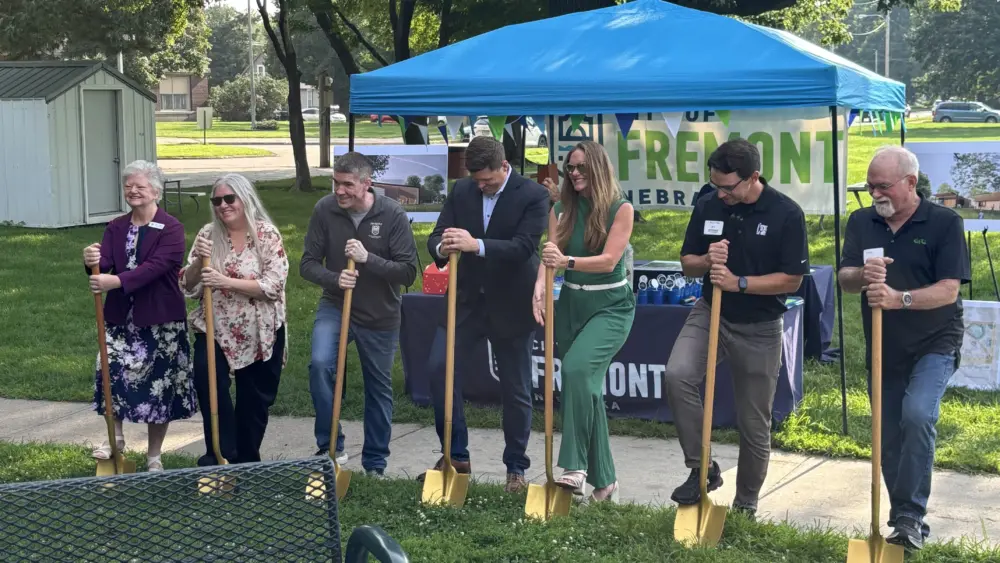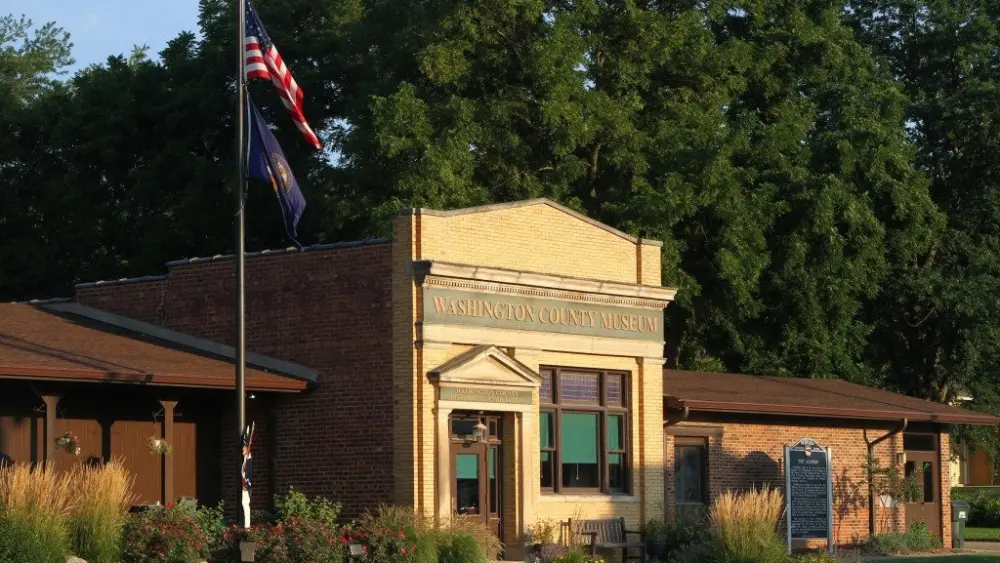
The Blair Crossing Apartments project is rising at Nebraska Highway 133 and U.S. 30 is said to be first major apartment complex in about 25 years in the town north of Omaha. (Courtesy of trb architecture)
CINDY GONZALEZ
Nebraska Examiner
BLAIR — Blair is about to get its first new major apartment complex in a quarter-century — a 132-unit market rate project the public is chipping in for to help boost business and growth in the town a half hour north of Omaha.
Real estate developer Metonic broke ground earlier this month on the $27 million Blair Crossing Apartments, which will feature amenities including a fitness center, dog park and resort-style swimming pool.
Public incentives helping to defray costs include $300,000 in local tax revenue from the city’s “LB 840” program and up to $2.03 million in tax-increment financing. TIF allows property tax revenue from new improvements at the project site to pay for eligible expenses of development.
The city of about 8,000 residents also pledged $2.4 million for area public road and infrastructure improvements that City Administrator Phil Green said not only will benefit apartment access but also should ignite surrounding commercial growth that bumps up property and sales tax revenues.
“We’re hoping that this Blair Crossing development becomes the kickstarter to see even more development in that area,” said Green. “Invest a little now, so you get a bigger payoff down the road.”
Housing crunch
It’s part of a strategy to increase housing options in a town whose job base has expanded but where further growth is threatened by limited and aging housing availability. Blair is among communities across Nebraska exploring ways to address housing affordability and supply, a challenge that a statewide report said had reached crisis proportions.
Mike Rooks, executive director of Gateway Development Corp., which is the economic development arm of Washington County, said Blair businesses have struggled to recruit workers amid a housing crunch.
He believes the shortage also has discouraged some companies from opening or relocating there.
“The CEO will look at me and say, ‘Where are my employees going to live?’” said Rooks. “So this is another tool in our toolbox that we can show.”
Currently, Rooks said, about 3,500 Omahans drive to Blair to work, and about 2,000 Blair residents drive to Omaha to work.
At Blair’s expanding bioscience campus, more than 60% of employees commute there to work, officials said. The campus includes companies such as Cargill, Corbion, Novonesis (formerly Novozymes), NatureWorks and Evonic.
Meanwhile, over the past four years, Blair has seen more than $500 million in capital investment, Rooks said. That includes a Dollar General distribution center officials say employs nearly 700 people. Just last month, a new $100 million Calcium Products project was announced.
Calcium Products, an agricultural technology company specializing in pelletized high-calcium lime and gypsum, bought 113 acres in Blair South Industrial Park to construct two new production facilities. The project is to create about 50 new full-time jobs when scheduled to open next year and also will spur a new rail yard that’s expected to lure additional industrial-focused business.
Rooks expects the Blair Crossing Apartments to be “gobbled up” when they are scheduled to open in 2026. He and Green said Blair hasn’t had a newly built major apartment building since around 2000.
Metonic developers said that about 67% of the Blair housing stock was built prior to 1990, so Blair Crossing will offer a contemporary living option.
The residences should be attractive to Omaha workers as well, Rooks said, offering a modern small-town living option a short drive from the amenities of a bigger city.
He said a 2021 study of Blair and five smaller Washington County municipalities foresaw a demand for more than 500 new housing units by this year. They haven’t “even scratched the surface,” said Rooks.
‘Almost unheard of…’
The four-building, three-level Blair Crossing complex is rising on roughly six acres at the convergence of U.S. 30 and Nebraska Highway 133. Dwellings will range in size from studio apartments to three-bedroom units, with rents likely to run from $1,200 to $2,000.
Metonic President Kassie Inness said in a statement that she felt strong local support for the project and has not seen anyone stand up in opposition. “That is almost unheard of in multifamily development,” Inness said.
Metonic partners include general contractor Ronco Construction, Ruff Grading, trb architecture, Lamp Rynearson, Veridian Credit Union.
Rooks said Blair public officials have come to believe that the city “has to step up” with public incentives in order for real estate developers to invest there. A housing advisory committee appointed by Blair Mayor Mindy Rump has recommended various approaches to help bring housing of different styles and prices to the area.
The $300,000 in “LB 840” funds for Blair Crossing was possible via Nebraska’s Local Option Municipal Economic Development Act. That law allows cities, given local voter approval, to use local tax revenue for economic development, including housing initiatives.
In Blair’s case, voters first gave the green light in 2006 to use a portion of the local sales tax for an LB 840 program, and last year reauthorized a program for 12 more years.
Green said the city also agreed to cover $2.4 million of a $3.2 million cost, with the rest paid by developer Metonic, to improve access and highway connections around the apartment complex.
He said the project site and surrounding land had remained undeveloped largely because of costly changes needed to link the area to major roadways.
“It was a project that wouldn’t happen if the city hadn’t contributed something,” Green said.
‘Show incentives’
Green said a recommendation from the city’s housing advisory panel encouraged use of incentives to help make land more alluring for development.
Tax-increment financing is an economic development tool authorized decades ago by the Nebraska Legislature, though it has become increasingly controversial. City Councils, following a public hearing process, must give thumbs up or down for each TIF project.
Critics, including some lawmakers, say TIF in some cases has been used too generously and perhaps on projects that a developer might have undertaken without the incentive. Part of the concern is that the new property tax collected on the improved portion of a project site is redirected, for up to 20 years, to help pay off development expenses rather than being sent to traditional recipients such as schools and local governments.
After that TIF period of 15 to 20 years, all property tax at the site flows to the traditional recipients.
Rooks said public incentives have become increasingly important for smaller Nebraska communities like Blair.
“We have to show incentives and we have to show them why they need to come here,” he said.











